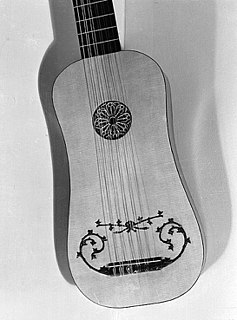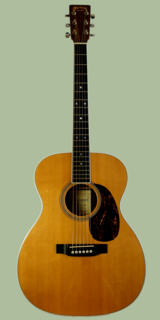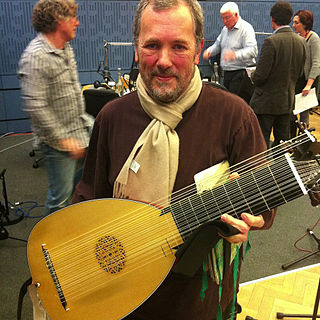
The classical guitar is a member of the guitar family used in classical music. An acoustic wooden string instrument with strings made of gut or nylon, it is a precursor of the acoustic and electric guitars which use metal strings. Classical guitars are derived from the Spanish vihuela and gittern in the fifteenth and sixteenth century, which later evolved into the seventeenth and eighteenth century Baroque guitar and later the modern classical guitar in the mid nineteenth century.

A lute is any plucked string instrument with a neck and a deep round back enclosing a hollow cavity, usually with a sound hole or opening in the body. More specifically, the term "lute" can refer to an instrument from the family of European lutes. The term also refers generally to any string instrument having the strings running in a plane parallel to the sound table. The strings are attached to pegs or posts at the end of the neck, which have some type of turning mechanism to enable the player to tighten the tension on the string or loosen the tension before playing, so that each string is tuned to a specific pitch. The lute is plucked or strummed with one hand while the other hand "frets" the strings on the neck's fingerboard. By pressing the strings on different places of the fingerboard, the player can shorten or lengthen the part of the string that is vibrating, thus producing higher or lower pitches (notes).

The viol, viola da gamba[ˈvjɔːla da ˈɡamba], or (informally) gamba, is any one of a family of bowed, fretted and stringed instruments with hollow wooden bodies and pegboxes where the tension on the strings can be increased or decreased to adjust the pitch of each of the strings. Frets on the viol are usually made of gut, tied on the fingerboard around the instrument's neck, to enable the performer to stop the strings more cleanly. Frets improve consistency of intonation and lend the stopped notes a tone that better matches the open strings. Viols first appeared in Spain in the mid to late 15th century and were most popular in the Renaissance and Baroque (1600-1750) periods. Early ancestors include the Arabic rebab and the medieval European vielle, but later, more direct possible ancestors include the Venetian viole and the 15th- and 16th-century Spanish vihuela, a 6-course plucked instrument tuned like a lute that looked like but was quite distinct from the 4-course guitar.

The vihuela is a guitar-shaped string instrument from 15th- and 16th-century Spain, Portugal and Italy, usually with five or six doubled strings.
John Johnson was an English lutenist, composer of songs and lute music, attached to the court of Queen Elizabeth I. He was the father of the lutenist and composer Robert Johnson.
Raymond "Ray" Lynch is an American guitarist, lutenist, keyboardist, and composer. He began his musical career in 1967 by performing in The Renaissance Quartet in New York City before leaving in 1974 and giving up his musical career. During his hiatus, Lynch studied with his spiritual teacher, Adi Da, who would ultimately encourage him to return to music. Lynch released five albums during the 1980s and 1990s, including Deep Breakfast, No Blue Thing, and Nothing Above My Shoulders but the Evening. Initially producing his music independently, Lynch eventually worked with Music West. After Lynch sued and left the company, Lynch joined Windham Hill in 1992 before retiring in 2000. Lynch has won three Billboard awards.
Alonso Mudarra was a Spanish composer of the Renaissance, and also played the vihuela, a guitar-shaped string instrument. He was an innovative composer of instrumental music as well as songs, and was the composer of the earliest surviving music for the guitar.
Hopkinson Smith is an American lutenist and pedagogue, longtime resident in Basel, Switzerland.

The Baroque guitar is a string instrument with five courses of gut strings and moveable gut frets. The first course sometimes used only a single string.
The evolution of classical guitars began with the influences of the vihuela and gittern in the sixteenth century and ended with the modern classical guitar in the mid nineteenth century.

An acoustic guitar is a guitar that produces sound acoustically by transmitting the vibration of the strings to the air—as opposed to relying on electronic amplification (see electric guitar). The sound waves from the strings of an acoustic guitar resonate through the guitar's body, creating sound. This typically involves the use of a sound board and a sound box to strengthen the vibrations of the strings. In standard tuning the guitar's six strings are tuned (low to high) E2 A2 D3 G3 B3 E4.
The Harp Consort is an international Early Music ensemble directed by Andrew Lawrence-King, specialising in Baroque Opera, early dance-music, and historical World Music.

The Mexican vihuela[biˈwe.la] is a guitar-like string instrument from 19th-century Mexico with five strings and typically played in mariachi groups.

Nigel North is an English lutenist, musicologist, and pedagogue.

The eleven-string alto guitar is an extended-range classical guitar developed by Swedish luthier Georg Bolin in the 1960s.

John Griffiths is a musician and musicologist specialised in music for guitar and early plucked instruments, especially the vihuela and lute. He is known internationally for his research on many aspects of the sixteenth-century Spanish vihuela, its history and its music. He has also had an international career as a solo lutenist, vihuelist, and guitarist, and as a member of the pioneer Australian early music group La Romanesca. After a thirty-year career at the University of Melbourne (1980–2011), he now works as a freelance scholar and performer.
Roger Harmon is an American musicologist and lutenist who taught lute at the Peabody Conservatory in Baltimore, Maryland. He is noted for founding the Baltimore Consort in 1980 with flutist Mindy Rosenfeld, which performed successfully for several years before releasing On the Banks of the Helicon, their first album for Dorian Recordings. Roger Harmon's research has focused mainly on ancient music theory.
Christopher Wilson is a British lutenist.
Peter Croton is a Swiss-American lutenist and guitarist. He has attained prominence in his field through his numerous recordings, performances, publications, and teaching engagements. His recorded repertoire includes music from the Renaissance, Baroque and Classical periods, as well as his own compositions. His publications include a figured bass manual for classical guitarists and publications of compositions for voice and lute.
Lex Eisenhardt is a performer and recording artist on early plucked instruments, such as the vihuela, the baroque guitar, and the 19th-century Romantic guitar. He studied lute and guitar at the Utrecht Conservatory. In 1981 he was appointed professor of guitar and early plucked instruments at the Sweelinck Conservatorium. In the forefront of the Historically Informed Performance (HIP) on the guitar, Eisenhardt was the first to make several gramophone recordings with music by the Catalan composer Fernando Sor on a period instrument from the early 19th century. He has given solo recitals and lectures in many European countries, Australia, and the United States. Well-known guitarists such as Johannes Moller and Izhar Elias studied with him.













